How the cd actually works,
an impersonated overview based on the original document of end 80-ies
THE BENEFITS OF COMPACT DISC DIGITAL AUDIO
The System
– The ultimate in sound reproduction.
– Effective protection against dirt and scratches.
– N0 wear on disc or pick-up.
– Incomparably simple, versatile and convenient to use.
– Compatible with existing audio equipment.
– Pocket-sized disc.
– Uninterrupted playing time of up to 72 minutes stereo sound.
The Sound
– Greatly improved signal to noise ratio.
– Full audio frequency range.
– Negligible distortion.
– Complete channel separation.
– Complete absence of rumble, wow and flutter.
– Insensitive to microphony, shock and vibration.
– No degradation in time.
The number one sound reproduction system Compact Disc Digital Audio.
The ultimate sound reproduction system.
The Sound is audibly superior, and the control facilities are fast, accurate and very convenient The long-playing, single-sided silver discs withstand scratches, heat and moisture, and take up little storage space. Now there are Compact Disc players for
indoor, outdoor and in-car use, and thousands of disc titles to choose from. Small wonder that Compact Disc has become the most sought-after music system.
Compact Disc sound is superior because of brand-new technology; optical readout and digital signal processing techniques produce exceptionally accurate audio signals. From breathless silence to ear-splitting crescendo, from rumbling bass to piercing treble, Compact Disc regenerates the fine details of the recorded sound.
Channel separation, a thousand times higher than with record players, creates an astonishingly clear stereo image. There is no wow and flutter, no rumble, and the laser beam cannot wear or scratch the recording. Compact Disc convenience is unrivalled too. Players find any part of any disc at a button touch. Programmed playback of favourite tracks is fast and easy. And the variety of useful information displayed to the user is simply not available with other systems. Compact Disc Digital Audio is very largely a product of Philips research,development and foresight. We take pride in the leading role we played in establishing the system as a world standard. And in the fact that Philips players are recognised as the best for sound quality and operating convenience
The digital concept
Digital techniques are nothing new. In a primitive way, they have been applied for centuries. But the development of semiconductors has opened the way to astonishing possibilities. Today, the ubiquitios microchip is changing the structure of commerce and society through the speed and flexibility of computers and information processing systems, the accuracy and ease of digital tuners, digital calculators, digital clocks and watches – and Compact Disc.
One striking feature distinguishes digital systems from the more familiar analogue systems. They work purely with numbers, instead of with physical quantities like voltage or current. And whereas physical quantities vary, for example, as the equipment heats up, the supply voltage alters, and components begin to age, numbers always represent exactly the same values. Provided that the numbers are properly preserved, digital systems operate with complete accuracy.
A simple illustration of both analogue and digital concepts is a road map. Distances are represented in analogue form by the length of the road lines, and in digital form by numbers printed alongside the lines. It is easier, faster and more accurate to read the numbers than to measure the length of the lines. A very appropriate example, because road maps in their present form may quite soon be replaced by the computerised Philips CARIN Car Information and Navigation system, which uses electronic maps coded in completely digital form – and recorded on Compact Disc!
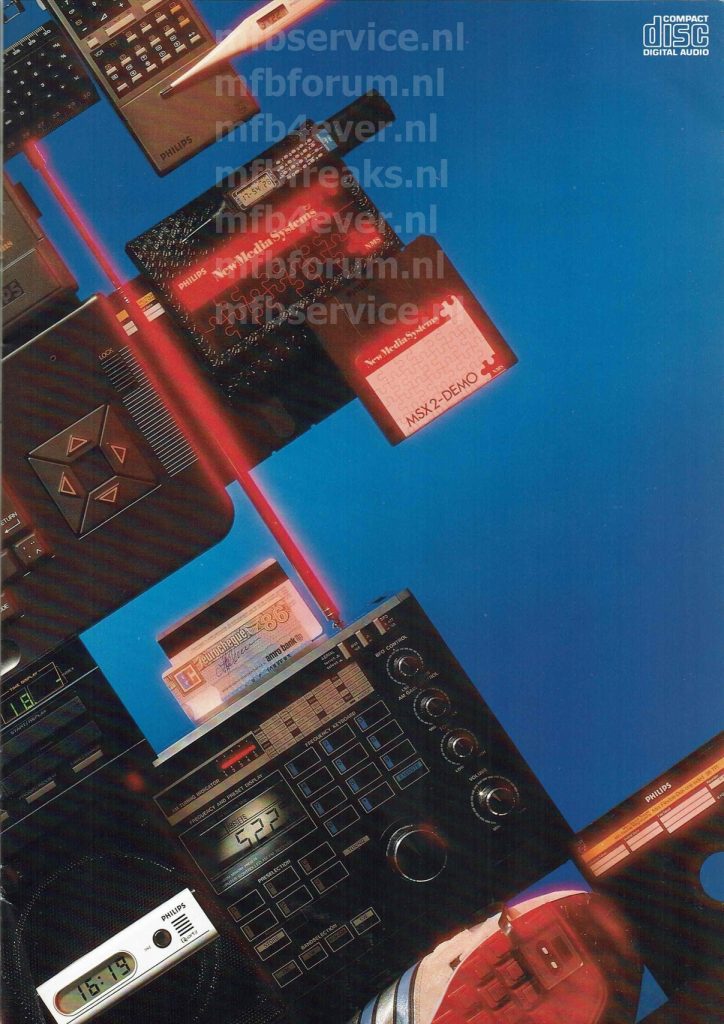
The Compact Disc Sound Process
The original, analogue, sound input waveform (1) is measured at regular intervals; sampling (2).
In an analogue-to-digital converter, the measured values are changed into binary numbers; quantization (3). The numbers are encoded into a pulse train (encoding), in a process called Pulse Code Modulation; PCM (4).
The pulse train is recorded as a pit pattern on the Compact Disc. (5) A space between these pits is called a land, and during reading a change from a pit into a land or a land into a pit is a “1” in binary data, thus while no-change is a “0”. In the Compact Disc player, the reverse operation is performed.
The pulse train (6), read from the disc, is decoded into binary numbers, then reconstituted into sample values in a digital-to-analogue converter (7). Finally, low-pass filtering takes away the sharp edges to produce an output waveform virtually indistinguishable from the original (8).
The waveform is sampled at high speed, and the value of each sample is measured. Each value is then converted into a digital number in binary code (in digital terms this is known as a word or symbol). The string of successive binary numbers is the exact digital equivalent of the audio waveform. As long as the numbers retain their true values, the waveform is expressed with an accuracy that depends only on the sampling speed and the resolution of the binary number.
Binary Numbers
Every decimal number has its binary equivalent. The smallest unit in binary notation is called a ’bit’. usually written as ’0’ or ’1′.
The unit of binary code is the bit (Binary digit). A single bit can express two numbers, 0 and 1. Two bits express four numbers, 00, 01, 10 and 11 (equivalent do decimal numbers 0, 1,2 and 3). Each bit added doubles the total of available numbers.
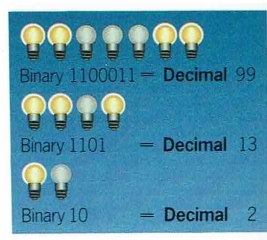
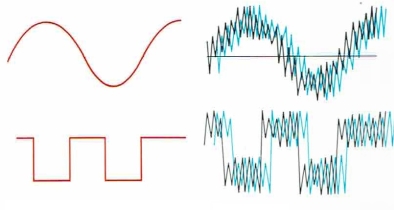
Noise behaviour in analogue and digital systems
Noise in an analogue system is hard to remove because it is superimposed on the actual information expressed in the waveform. In a digital system the noise is superimposed on information expressed in changes between high and low level. These changes remain recognisable at noise levels not tolerable in an analogue system.
0 and 1, the only two conditions of the binary code, can conveniently be re presented by the electrical states ’on’ and ‘off. As long as the digital circuitry can distinguish these widely different conditions, the string of numbers will be perfectly preserved. Noise in the ordinary sense can be high without having any effect. With digital recording and reproduction, harmonic and intermodulation distortion are very low, and there is no wow and flutter. The low distortion results from the high accuracy of the analogue-to-digital and digital-to-analogue conversion, while wow and flutter are eliminated by quartz crystal controlled clocking of the digital readout rate.
Because the digitally-coded signal consists of a sequence of individual numbers, it is possible to insert extra information, and to manipulate the sequence, without affecting the main (sound) information at all. In this way, automatic error correction can be introduced, to compensate for quite substantial defects in recordings, or lapses in the electronic circuits. Perfect results can still be obtained, even with flaws in the system. Furthermore, control and display codes, such as contents lists, track and index identifications, and supporting text or graphics, can be inserted. Much of the convenience of Compact Disc is due to such codes.
Digital sound reproduction
Sound is a variation of air pressure detecatble by the ear. Analogue audio systems work by converting air pressure variations into electrical voltage or current variations, processing them in various ways, such as making and playing a record or tape, or broadcasting by radio, and then reproducing the sound waves through loudspeakers. Preferable mfb speakers as you can read on https://www.mfbfreaks.nl These analoge systems still are very near their final performance limits today. Analoge sound reproducing devices such as cassette-players and record-players yet still they do not reproduce the original sound exactly and consrstently. The achievable figures for such factors as signal to noise ratio, distortion and channel separation are not good enough for really true-to-life sound. And other inescapable factors such as non-linearity, power supply and temp erature variations, and ageing, all affect the shape of the analogue waveform as they pass through the system. With digital techniques, the road to substantial performance improvement is wide open, because the audio waveform is expressed in precise numbers, which are not affected by physical variations.
The Philips philosophy – full digitalisation
Even in digital systems, sound reproduction begins and ends in the analogue domain. The Philips philosophy for Compact Disc is that the system should be as digital as possible. That is why we have encouraged the production of fully digital recordings, from the microphone onwards. And why, in Philips Compact Disc players, there are no analogue circuits where digital circuits can be applied. A wellknown example is double digital filtering, conceived by Philips, and vastly superior to conventional analogue filters used in other players. We believe that Philips full digitalisation produces the best sound. And so do many critics and test institutes all over the world.
To establish a consistent, recognisable pattern, the data stream is assembled into major groups, called frames, as shown here. Each frame begins with a synchronisation pattern, which establish es playback speed and timing. Control and Display
The eightbit control and display symbol contains the track, index and timing codes that make Compact Disc so convenient to use.
Graphics
Also provided for, but not presently used are special codes for text and graphic display of supporting information such as titles, composers, scores or scripts.
Audio Data
Twelve 16bit data words, each split into two 8-bit symbols, are grouped in two blocks. The sequence of data words represents the two stereo channels alternately.
Error Correction
The two pairs of error correction words employ the extremely powerful Cross Interleaved Reed Solomon Code (CIRC) Theoretically, CIRC will correct error bursts up to 3500 bits, corresponding to a track length of 2.4 mm. Even beyond that, it will compensate, by interpolation for error bursts up to 12000 bits (up to 8.5 mm of track). This provides an effective margin of tolerance, both for disc manufacture and for scratches and marks occuring in use.
Eight-to-Fourteen Modulation
To pack the data at higher density, ensure accurate timing, reduce the possibility of interference between symbols on adjacent tracks arising from light spot overlap, and eliminate low-frequency audio signal components which could upset the operation of the player servo systems, the original data stream is converted into a somewhat more complex code by a process known as EFM (eight-to-fourteen modulation). In EFM, extra bits are added to convert the 8-bit symbols into 14bit symbols. With three additional ’merging’ bits, each symbol finally comprises 17 bits.
One sample in 6-bit quantized digital form.
(A 16-bit word is made up of two 8-bit symbols) Theoretically, each bit contributes 6 dB to the signal-to-noise ratio. 16 x 6 = 96dB.
CD ENCODING
The information recorded on a Compact Disc is not simply sound, as with conventional records or tapes. The high-quality sound information is encoded together with extra codes in an internationally agreed format. This special encoding process preserves and improves the sound quality, counteracts dropouts, and provides the control and display data that makes the system so fast and convenient to use.
By using sixteen bit sample words, the fundamental CD coding format offers extremely high resolution. And each bit contributes a theoretical 6 dB to the signal-to-noise ratio, to create a dynamic range much bigger than any previous system has been able to offer.
The frequency range covered depends upon the sampling rate. This must be at least double the highest frequency required. At 44.1 kHz, the Compact Disc sampling frequency caters comfortably for the full audible range up to 20 kHz. Channel separation is also very high, because the sequence of values for the left channel is inherently independent of the sequence for the right channel.
An optical system concentrates the laser beam to a spot less than 1 micron (pm) in diameter, capable of reading the densely packed recording in the Compact Disc. This recording consists of a continuous track of pits in a brightly reflective surface. The pits are microscopic – only 0.5 um wide. 0.1 um deep and 1 to 3 um long, at a track pitch of 1.6 um.
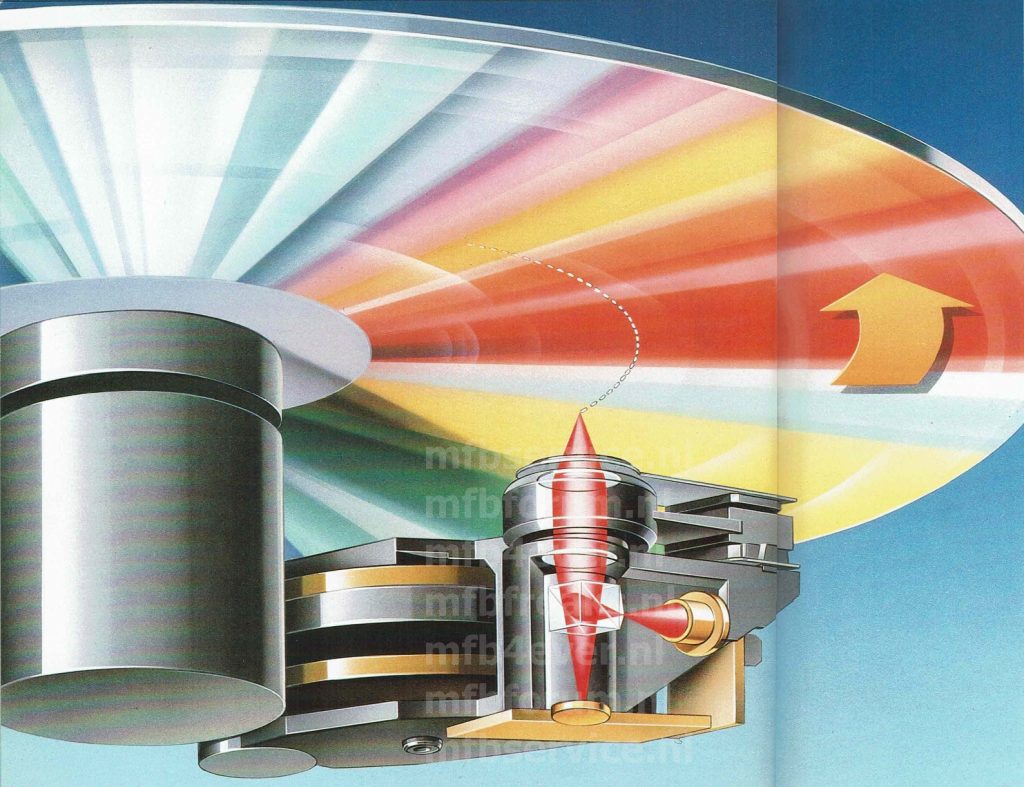
As the disc rotates, the laser scans the pit pattern. When the beam falls on a flat surface, it is reflected. The optical system guides the reflected beam to an array of photodiodes. When the beam falls into a pit, it is scattered. Very little light finds its way through to the photodiode array. The flats and pits on the recorded track are thus read as ’on’ and ’off‘ impulses by the photodiode array. The sequence of impulses forms the data stream of channel bits for the player electronics. The beam reads the recording from the inside to the outside of the disc. A servo system holds the spot in focus on the recording surface, compensating for disc warp or any other unevenness in disc rotation. A second servo compensates for eccentricity and holds the beam on the track. This tracking servo is also used to move the beam across tracks, to gain fast access to any part of the recording, and to create pauses in the music.
Tracking and Focusing: choosing the best method
Player performance depends heavily on effective tracking and focusing. Eccentricity may swing the rotating disc up to 300 um from side to side, but the spot should follow the centre of the track within 0.1 um. Disc warp may be as much as 1 mm, but the spot should focus on the track within 0.5 um. The spot should also stay in position in spite of shock, vibration or dropouts. But it needs to cross tracks quicklyfor track skip or music search. These are tough requirements. But the Philips CDM2 Laser Assembly, with its control servos, meets them all.
Single-spot or 3-spot Beam ?
A single-spot beam can be mounted on a pivoted arm or a linear tracking sledge. Philips use a pivoted arm, which moves very fast for track access, and is highly sensitive to tracking corrections.
The traditional disadvantages of the pivoted arm do not apply to a laser beam pickup, with its electronic servos. A 3-spot beam must be mounted on a linear tracking sledge, which may compromise the fast access and tracking sensitivity. At the same time, the secondary spots are vulnerable to interference from adjacent tracks, which can affect tracking and focusing. For tracking, Philips players use a single-spot laser on a low-inertia pivoted arm, in preference to a 3—spot laser on a linear tracking sledge. The pivoted arm, with linear magnetic drive, moves faster (less than a second from inner to outer track). it follows large eccentricities easily, withstands bumps well, and, with only one moving part, is reliable and longwearing. Mechanically isolated by fully floating suspension, it is practically immune to shock and vibration.
OPTICAL READOUT
Apart from digitalisation, Compact Disc Digital Audio introduces another very significant innovation — optical readout using a laser beam. In essence, a laser is a source of highly concentrated light which can be very sharply focused. The word ’Laser, in fact, stands for Light Amplification by Stimulated Emission of Radiation, and because of the precise nature of the beam, the laser principle has already found many applications in science and industry. The Compact Disc laser, a small, low-power semi-conductor (aluminium gallium arsenide) unit, emits invisible infra-red light. The Compact Disc optical read-out system achieves a read-out accuracy, from an extremely high-density digital recording, that no mechanical system could ever hope to attain. Dust particles and scratches sit on the disc surface, out of the focus of the laser beam. Because the beam is highly convergent, most particles and scratches are small in relation to the spot diameter at the disc surface, and have little effect on the intensity of the reflected light.
Philips CD Optical Readout System
The beam from the laser is reflected by a special semi-reflecting mirror to the lens system, which keeps it in sharp focus on the recordirig in the Compact Disc. Beam reflections returning through the lens system pass straight through the semi-reflecting mirror and on to the photodetector.
Because the read-out is optical the ‘pickup’ causes no more wear to the recording than reading causes to the words printed on this page. In fact the reflective track surface is covered with a transparent plastic seal, which affords permanent protection. The very high opening angle of the objective lens keeps surface scratches, dust and dirt well out of focus, and only really large marks are detected by the photo diodes. Even then, the CIRC error correction system increases the capability to cope with severe optical distortion arising from dirt or damage.
Philips full-integration decoding – for the highest performance and reliability
Philips players incorporate fullintegration electronics to handle virtually all aspects of Compact Disc decoding. That is the way to reach the highest performance and reliability.
Maximum-Strategy Demodulation and Error Correction
Exclusive single-chip demodulation and error correction achieves the maximum obtainable performance for both functions. The demodulator phaselocked loop has virtually no external components and the voltage-controlled oscillator is fully integrated. A large, centre-seeking FlFO (First-in, FIrst-out) memory absorbs data rate variations. giving very good protection against bumps and vibrations.
Dual 16-bit Digital-to-Analogue Conversion
The dual 16bit DAC, operating at the quadruple oversampling rate of 176.4 kHz, needs no multiplexing because the L and R channel converters are completely separate. This technique eliminates delay between the stereo channels, and adds an extra 4 dB to the channel separation. The DAC uses a technique called ’dynamic element matching’ to generate high-accuracy binary weighted currents with long-term stability. In other words, precise output waveforms throughout the life of the player.
Meanwhile, the derived clocking signal is compared with a reference frequency from a quartz master oscillator. Any discrepancy generates an correction signal for the discmotor speed servo system. In conjunction with the data stream clocking procedure, this makes wow and flutter completely inaudible.
The sub-code data fed to the control and display circuits includes the disc ‘contents list’ of tracks, indexes and playing times, and codes that identity the tracks and indexes. This information is used by the control circuits for fastaccess music search and programming. It also forms the basis for displays that can show the exact state of play.
Digital filtering
Filtering is necessary to remove sampling noise from the decoded waveform. Recognising that analogue filtering would inevitably distort the waveform, Philips designers introduced digital filtering. This Is probably the best known feature of the Philips approach to creating authentic Compact Disc sound. The filter has no audible effect at all on the audio signal. Phase response is linear within 0,5°, passband ripple is less than 0.02 dB, and roll-off is optimised for excellent impulse response, with 60 dB stop-band attenuation.
The test disc 5A
This Philips Test Disc checks error correction performance. The wedge simulates interruption in the inormation layer. The dots simulate suface marks.
The thin lines simulate a fingerprint. Philips players must accept a certain wedge width, a certain dot size, and the fingerprint, without perceptible music interruption.
The Philips adaptive error correction cicuit is the first in any CD player to utilise the full error correction capacity of the CRC code. It automatically matches the correction strategy to the actual error pattern. More corrections can be made, with higher reliability, to obtain the purest possible sound, without perceptible interruptions.
CD Decoding
Decoding regenerates the stereo sound waveforms from the digital signal picked up by the photodiode assembly. It is the most important task of the player electronics. The decoding circuits perform four distinct functions: demodulation, error correction and interpolation, digital-to-analogue conversion, and filtering. Demodulation retrieves the 8-bit format from the 14-bit EFM format. The synchronisation pattern is separated out and used to establish clocking (timing). Clocking smoothes out jitter (small timing errors) in the data stream caused, e.g. by disc speed variations. The subcode data is also extracted for the control and display circuits.
ClRC error correction then restores missing data in correctable dropouts. ln larger dropouts, information is lost, but interpolation substitutes averaged values to prevent any clicks or pops in the sound. The data stream now consists of a sequence of left and right channel values. These are demultiplexed (separated), converted back to analogue form, and filtered to provide inputs suitable for a conventional stereo (pre-)amplifier.
Compact Disc Digital Audio
The Player in simple schematic form
A precision electric motor spins the Compact Disc. The microscopically sharp point of the laser beam reads the digitally recorded information inside the disc. In the optical readout system, the digital Information is divided into audio information and servo control information.

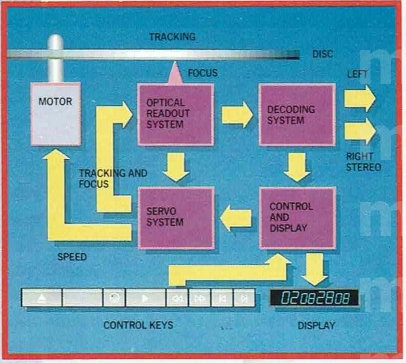
The decoding system then converts the digital audio signals into conventional, but highly accurate, audio waveforms for the left and right channels of a stereo system. Meanwhile, the servo control information governs the servo systems which maintain precise control over turntable motor speed, laser beam tracking and laser beam focus. The control and display system is an electronic brain; it not only offers easy, convenient fingertip operation, but can also display extensive information concerning the disc contents and the state of play.
The single-spot laser optics are simple, yet completely effective. They need no critical adjust ment, and, unlike the 3-beam type, there is no interference from adjacent tracks.
Foucault (knife-edge) focusing is used in Philips players, in preference to the astigmatic (cylindrical lens) method, to avoid noise and crosstalk in the servo Control signals.
Fully integrated servo electronics simplify the laser assembly by performing as many functions as possible electronically Selfcorrecting circuits feature automatic asymmetry control, automatic gain control and track loss detection. They not only eliminate loss of performance with soiled discs or ageing, but also the need for mechanical adjustments. Even during dropouts, the beam remains steadily on track – a capability lacking In mast other players.
Programme production and tape mastering
Existing analogue recordings usually sound a lot better when transcribed on to Compact Disc. But the full superiority of the system only becomes apparent with completely digital recordings. These clearly show the amazingly low noise and distorsion levels. Many fully digital (DDD) recordings are now available on Compact Disc.
The first stage in making a disc is the Production Master tape. Produced in the recording studio, and preferably digital. It contains the complete audio information, edited, equalised and sound balanced. In the Compact Disk Mastering facility, this Production Master tape is converted into the CD Master tape. The control and display sub-code is added, and the resultant digital recording is encoded in characteristic CD frame format, including synchronisation and error correction. Precise checks are carried out at every stage.
Disc mastering
From the checked and approved CD Master tape, the CD Master Disc is made. A glass disc, optically ground polished and spotlessly clean, is coated with about 0.1 um photoresist evenly distributed by spin-coating. This forms the Resist Master disc. It is compaitable with a photographic film. The encoded digital information is recorded (cut) on a CD Disc Master Recording system. The high power recording laser, modulated by the signal from the CD-Tape Master, writes a corresponding pattern of pits in the photo-resist. Photographic development, followed by a silvering process then results in the CD Master disc, carrying the actual pit structure required in the production discs.
Stamper making
In the disc production facility the silvered CD Master disc is electroplated with nickel. When the plating is separated from the CD Master disc, it forms a metal ‘negative’, known as the ‘Father’. This is the master tool for the replication process, it could be used directly as the stamper to produce discs, but only for limited quantity production. The normal procedure is to ‘plate on’ and produce one or more ‘positives’ (‘Mothers’) from the ‘Father’, and then a series of ‘Sons’ or production-line stampers from each ‘Mother’.
Pressing and finishing
Compact Discs are pressed in a similar way to conventional records, using stampers in compression or injection moulding techniques. The surface carrying the information pattern is coated with a microthin layer of aluminium to provide the reflective surface. Then, this fragile ‘mirror’ layer is protected with a lacquer coating, which is covered by the label. Finally, the disc is precision centered, and the centre hole is punched out. Because of the digital playback system, every disc that successfully passes final inspection will reproduce absolute top quality sound, indistinguishable from the original CD Tape Master.
Developing the mastering technology Philips, pioneers in optical recording, led the way in developing the unique Compact Disc mastering technology. This was done hand-in-hand with associate company PolyGram, who perfected the disc pressing technology. The first programme of Compact Discs for Europe was entirely mastered by Philips and pressed by PolyGram. Having taken delivery of Philips mastering equipment, PolyGram now have full mastering and pressing facilities. They run 24 hours a day, 7 days a week. And Philips disc mastering equipment is in great demand by disc manufacturers in Europe, the USA and the Far East.
THE COMPACT DlSC
The Compact Disc, only 12 cm in diameter, plays on one side only. Yet it can contain up to 72 minutes of stereo sound – more than equivalent to a presentday LP, and of indisputably higher quality.
The sound is recorded at 50-100 times higher density than on an LP. It is scanned at a constant linear velocity of 1.3 metres per second, the rate of rotation of the disc on the player changing progressively from 500 to 200 rpm as the laser beam tracks from inside to outside.
A layer of transparent plastic protects the recording. The laser ’pick-up’ beams through this layer to focus directly on the information surface. There is no physical contact to wear the recording out and, unlike all other prerecorded source material, it does not deteriorate with use, storage or age. Digital data are close to the upper side of the Compact Disc. So a scratch on the label side could result in loss of data.
Like the conventional gramophone record, the Compact Disc is compression or injection moulded. It goes through the same stages of ore-mastering, mastering and replication. But the recording is optical, encoded, and at very high density. Completely new, automated mastering techniques are involved, for the unprotected master recordings are far too sensitive to be touched by hand.
THE SPREADING INFLUENCE OF COMPACT DISC
Compact Disc is not restricted to high-fidelity sound reproduction. tt has other, quite different, applications, and promises to be the medium of the future, not just for audio, but for the whole field of consumer electronics.
THE TALKING BOOK
With mono, instead of stereo reproduction, and by limiting the frequency range to 4 kHz, Compact Disc playing time can be extended to 12 hours. Sound quality is equal to that of MW/LW broadcasting. This is with a format conforming to the existing CD standard, using a modified CD player, which could be switched to normal CD audio. With a further change of format, playing times up to 32 hours can be reached.The Talking Book will be of particular interest to blind people. The available playing time is enough for readings of the majority of books, and the Compact Disc system is a lot more convenient to use than any of the tape systems presently being used by the blind. The players are easy to operate, the discs occupy a minimum of library space, and can be conveniently sent through the post.
CD ROM
As a digital system, CD can also be used for data storage and retrieval. This new development is known as CD ROM (ReadOnly Memory). A single CD ROM disc has a data storage capacity of 600 M Byte. This is equivalent to 1000 double-sided, doubledensity floppy discs, or 150,000 pages of text. For professional applications, dedicated CD ROM drives are already being used. A normal CD player, very simply modified, can also find data on a CD ROM disc very quickly, and read it out (into a home computer) very fast indeed. Soon such players will be hooked up to home computers. Not only for the kind of computer software available today, but for completely new applications made possible by the huge storage capacity of the disc. Such applications may well include directories, commercial catalogues, or encyclopaedias with sound, as well as words and pictures.
CARIN
The Philips CARIN Car Information and Navigation system, is another CD ROM application. CARIN will be able to take over much of the work of route planning and en-route navigation, giving the driver more freedom to concentrate on driving. In this application, the Compact Disc is an electronic map and guide book. The driver loads the disc into the CARlN CD player, and enters the destination point into the CARIN computer. The route is automatically planned and stored in the computer memory. During the journey, CARIN monitors progress and, gives the driver the navigation instructions needed to follow the route. The Compact Disc digital audio system is the accepted standard, worldwide. The CD ROM system is in fact a variation of that standard, already formulated and agreed to a very large extent. It may soon be as widely used as the digital audio system itself.